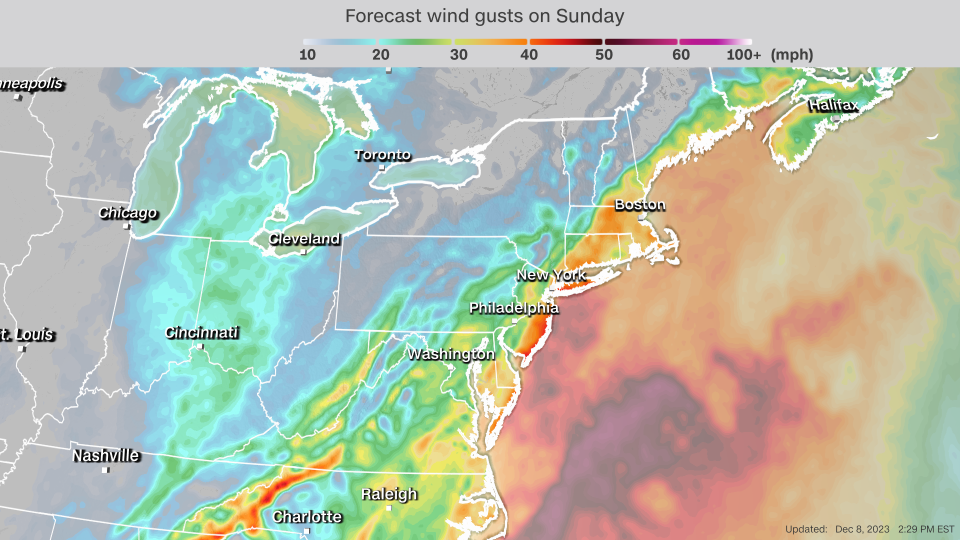A sprawling storm will impact much of the East this weekend with multiple hazards
A disruptive storm will unload heavy rain, severe thunderstorms, strong winds and even snow on the eastern half of the US through this weekend.
This wide-reaching storm could disrupt travel both on the ground and in the air across more than a dozen states and knock out power with its strong wind, especially in the Northeast.
The weekend storm began to take shape on Friday when an area of low pressure developed in the southern Plains. Energy left over from a deadly atmospheric river in the Northwest earlier this week will arrive in the central US and boost the strength of this storm.
Impactful weather held off until late Friday when the storm got better organized and tracked out of the southern Plains and into the Midwest.
Heavy rain, thunderstorms and gusty winds will reach the entire East throughout the weekend.
Saturday: Severe storms fire up
As the storm strengthens and expands its reach on Saturday, adverse weather will stretch more than 1,200 miles from the Gulf Coast to the Canadian border.
Thunderstorms rumbled to life Friday evening with a small window in which isolated severe thunderstorms moved across parts of Oklahoma, Arkansas and Texas, ahead of Saturday’s threat to the south.
The main thunderstorm event kicked off across portions of the South late Saturday morning as a cold front associated with the storm cut east across the region.

Some of these thunderstorms could become severe and deliver damaging wind gusts, hail and even tornados. A slight risk, or Level 2 of 5, for severe thunderstorms is forecast from eastern Texas through western Tennessee and northern Alabama, especially Saturday afternoon.
A “large, dangerous tornado” was confirmed near Rutherford, Tennessee on Saturday afternoon, according to a tornado warning from the National Weather Service (NWS).
Another large tornado was confirmed in Montgomery County near Clarksville, according to NWS. Officials in Clarksville are urging motorists to stay off roadways to make way for emergency first responders heading toward the storm damage.

At least three people were injured in a rural part of nearby Dresden Saturday afternoon, when severe weather struck the area, according to local emergency crews.
A tornado watch is in effect for much of middle Tennessee until 11 p.m. local time Saturday night, according to NWS.
As chances for damaging thunderstorms increased Saturday, the storm also spread rain across a wide portion of the country from the Gulf Coast to the Midwest. Rain began in the earliest hours of Saturday across portions of the Midwest and Mississippi Valley and spread east throughout the day.
Rain will become steady as the day progresses and could become heavy at times, especially from the Gulf Coast to the Ohio Valley. Fortunately, the storm is likely to move along at a brisk pace that will keep rainfall totals from skyrocketing, but any drenching rainfall could cause flooding issues.
Gusty winds will also accompany any rainfall, even outside of thunderstorms.
A thin stripe of accumulating snow is possible on Saturday from Wisconsin to Michigan’s Upper Peninsula, but this will be mostly a rain event for much of the Midwest.
Sunday: Strong wind event takes shape
The storm will reach its maximum strength by the afternoon as it expands and engulfs much of the East. Wind gusts from the storm will be quite a bit stronger on Sunday compared to Saturday and could knock out power and disrupt travel.
Widespread gusts of 40 to 50 mph will buffet the mid-Atlantic and Northeast. Gusts will crank even higher and reach up to 60 mph at times Sunday night in New England and coastal portions of New York and New Jersey.

Winds this strong, especially when coupled with drenching rain, could bring down a few trees and cause power outages. Strong winds and rain may also disrupt air travel across the busy corridor and lead to slowdowns for drivers.
Any unsecured outdoor holiday decorations may be blown away by the strongest winds.
Rain will be the primary precipitation type from Florida to New England, with widespread amounts of 1 to 2 inches likely. Higher totals are possible for areas drenched by multiple rounds of downpours.
Some thunderstorms will be embedded within the rainy area, even in the North. A few thunderstorms may become severe on Sunday, with an area from the Florida Panhandle to Virginia the most likely to endure a handful of damaging storms. Damaging wind gusts will be the main threat with these storms, but an isolated tornado is also possible.
Rain is likely to change to wet snow across higher elevations in West Virginia, Pennsylvania and much of upstate New York on Sunday night as cold air pushes into the East on the backside of the storm.
Portions of New England could change over to a wintry mix of rain, snow and freezing rain late Sunday night through Monday.
Exact changeover times and snow amounts will depend on how quickly cold air can rush into the region.
Monday: Cold envelops the East
The storm will start to push off the East Coast on Monday, but rain and snow will continue across much of New England and parts of upstate New York for much of the day. Wet snow could accumulate through Monday evening in the high elevations of Vermont, New Hampshire and Maine.
Rainy, windy weather will come to an end in New York City Monday afternoon while gusty winds slowly subside elsewhere in the Northeast, except for in New England. Strong winds will slam the New England coast into Monday night.
It’ll be much chillier on Monday across the eastern half of the country in the wake of the storm. The difference in temperature between Monday and the weekend’s above average December temperatures will be most stark from the Southeast to Northeast.
For more CNN news and newsletters create an account at CNN.com


